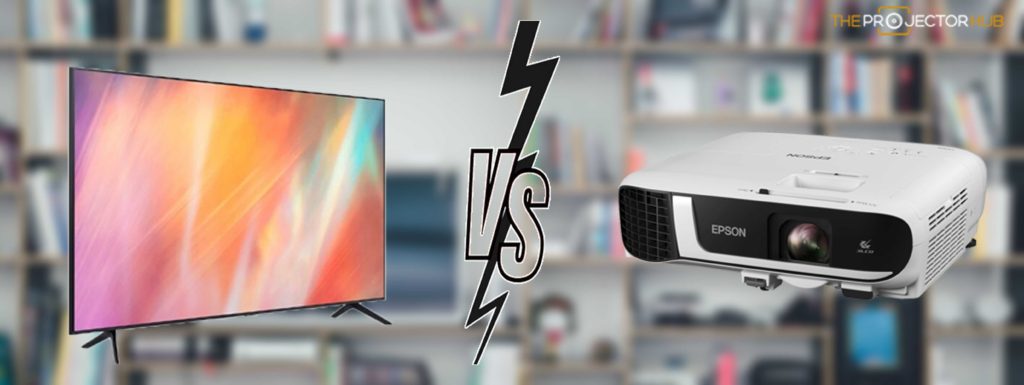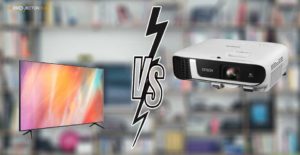 Are you looking to set up a home theater? However, you are concerned about projector vs flat screen for home theater. It used to be that if you wanted a great home theater experience, you needed to have a projector. But with the advent of high-quality flat-screen televisions, is a projector still worth it?
Are you looking to set up a home theater? However, you are concerned about projector vs flat screen for home theater. It used to be that if you wanted a great home theater experience, you needed to have a projector. But with the advent of high-quality flat-screen televisions, is a projector still worth it?
We’ll compare the two options and help you decide which is best for your needs. Keep in mind that there are pros and cons to both choices, so make sure to weigh all the factors before deciding.
projector vs flat screen for home theater
Flat-screen vs Projector: Resolution
Regarding resolution, 4K TVs are becoming more and more common, and 8K TVs are starting to trickle onto the market. But 4K HDR projectors are still prohibitively expensive for most people, and 8K projectors don’t exist yet. If you’re looking for the highest resolution possible, you’ll need to stick with a TV.
But that doesn’t mean that projectors are inherently inferior to TVs when it comes to resolution. In fact, some projectors can actually offer a higher effective resolution than even the best 4K TVs. That’s because projectors can use “pixel shifting” to increase their apparent resolution. The cost of these types of projectors is up to $2000.
Pixel shifting is a technology used in high-end projectors for years, but it’s only recently become affordable for the average consumer. Essentially, it works by slightly shifting the position of the projector’s lens every time it refreshes the image. This creates a sort of “stutter” effect, but it also allows the projector to display more pixels than it actually has.
So if you’re looking for the highest resolution possible, a projector with pixel shifting will be your best bet. However, these projectors are still quite expensive, and they’re not widely available yet. So if you’re on a budget, you’ll probably be better off with a TV.
Flat-screen vs Projector: Brightness
When it comes to brightness, projectors have a few advantages and disadvantages. Firstly, because they use light reflection instead of emitting light directly, they require less brightness to produce an image.
This can be a big advantage in rooms with little ambient light, as the picture won’t wash out as easily. However, projector bulbs dim over time and eventually need to be replaced, which can be costly.
On the other hand, flat-screen TVs use LED lighting, which is brighter than projector bulbs. This means that a flat-screen TV will usually provide a better picture in rooms with more ambient light.
However, flat-screen TVs do have one drawback in this department: their measured brightness is usually given in nits, not lumens. This means that they don’t produce as bright an image as projectors when both are set to the same brightness level.
In the end, it really depends on your viewing environment. If you want a bright and vibrant picture in any light, with little to no upkeep costs involved, you’ll want to go with a TV. However, if you can get your viewing room dark enough, a projector may provide a more comfortable viewing experience.
Flat-screen vs Projector: Contrast Ratio
The contrast ratio is one of the most important factors to consider when it comes to displaying quality; the contrast ratio is an important consideration. A high contrast ratio means that the difference between the darkest black and the brightest white that the display can produce is greater, resulting in a more vivid and realistic image.
Televisions usually have a higher contrast ratio than projectors. They can emit their own light, so they don’t need to rely on a dark room to produce a good image. On the other hand, projectors need a dark room to work well.
If you’re planning on using your TV in a bright room, then a projector is probably not the best choice. However, if you can control the light in your viewing environment, a projector can provide a great picture.
Flat-screen vs Projector: Screen size
Flat screens are typically found in homes, while projectors are usually in businesses and classrooms. Projectors can project a much larger image than a flat screen.
A typical flat screen is around 32 inches; think about the size when you pick out a projector. While a projector may project an image up to 200 inches wide, some are more versatile than others.
For example, short-throw projectors can be placed just a few feet from a screen or wall and still produce a large image, while ultra-short-throw projectors can be placed even closer.
Some projectors are even small enough to fit in your pocket. Pico projectors are a type of mini projector that can be used for business presentations on the go. They’re also popular for watching movies and videos in small spaces.
Keep in mind that pico projectors generally have a shorter lamp life and may not be as bright as other types of projectors.
The largest flat screen made (by Samsung called “The Wall”) was 1000 inches and cost around 1.7 million. One can purchase a projector that displays an image up to 300 inches for a fraction of that.
While projector image sizes don’t get as large as flat screen images, the average projector screen size will work for what most viewing needs.
Flat screen vs Projector: Lamp life
Projectors have a big advantage over flat-screen TVs when it comes to lamp life. A typical projector bulb will last for around 3,000 hours, while an LED TV will last for around 100,000 hours. While the lifespan of an LED television is fairly high, they are not yet the standard, LCD is – and they have a lifespan of 50,000 hours or 5 years.
You’ll need to replace your projector bulb about 10 times as often as your LED TV. However, projector bulbs are relatively inexpensive, so the cost of ownership is still lower for a projector than it is for a TV.
ex. Let’s say a projector bulb costs $66. if you have to replace it 10 times during the projector’s lifetime then that’s $660 (not including tax). If you paid $700 for the projector that is $1360 (again, tax not included).
Let’s also say that the projector you purchased has a max image size of 300 inches. For an LCD television with equal measurements you’ll pay 1.6 million dollars (I know right, that’s crazy).
Go with the projector
In addition, some projectors have features that extend the bulb’s life. For example, eco-mode can lower the projector’s power consumption, which will make the bulb last longer.
Projector modes that save lamp life: Eco mode (lowers brightness to a pre-set level), Super Eco mode (is used for advanced power saving purposes and dim screen while in use), Smart Eco mode (detects input content automatically to decide on brightness for highest contrast and color), LampSave (auto detects input content to decide on brightness for highest lamp life)
Flat-screen vs Projector: Inputs
Flat-screen TVs usually have more to offer than projectors when it comes to inputs. This is because TVs are designed to be used with various devices, while projectors are typically only used with computers.
Most flat-screen TVs have HDMI, component, and composite inputs. This means connecting your TV to a cable box, Blu-ray player, game console, and more.
Projectors usually have one or two HDMI inputs, and some also have VGA, DVI, and other types of inputs. However, you’re generally limited to using a projector with a computer or streaming device.
If you want to use your projector with a Blu-ray player, game console, or another device, you need to buy an adapter, usually. There are some projectors that comes with the option to connect to phones via MiraCast and other screen mirroring software.
Overall, which one is best Flat screen or projector
It depends on what you need. If you want a bigger screen go for the projector. If you watch TV in a bright room, go for the flat screen. If you need to save money on power, go for the projector. If you want more inputs, go for the flat screen.
Can you use a flat sheet for a projector screen?
You can use a flat sheet as a projector screen, but it won’t be as good as an actual projector screen. A flat sheet will diffract the light from the projector, resulting in a blurry image.
Can you use a projector as a TV?
Yes, you can use a projector as a TV, however, you’ll need to buy an adapter to connect your TV to the projector. This doesn’t really apply if your projector has certain software built in – you might be able to use it as a television right out of the box.
Do projectors use more power than flat-screen TVs?
Yes, projectors use more power than flat-screen TVs; however, the difference is not significant. A typical projector uses about 200 watts of power, while a typical flat-screen TV uses about 150 watts.
